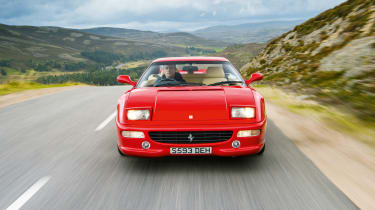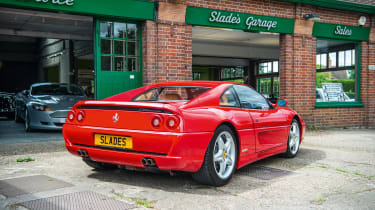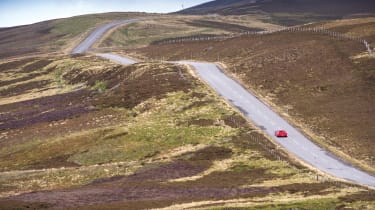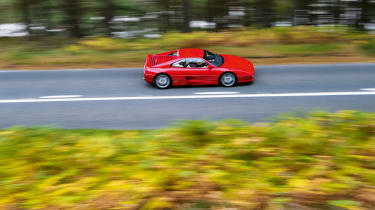Ferrari F355 - review, specs and buying guide
The Ferrari F355 introduced modern-day Ferrari and it’s still a great drive. Few evo 'icons', are more worthy of the name
Presented as ‘Ferrari’s £84,000 bargain’ on the cover of the July 1994 issue of Performance Car magazine (evo’s forefather), the Ferrari F355 bridges the gap between old Ferrari and new; between quaint, classic, small V8s and the recent 200mph V8 supercars. It’s the last hand-built Ferrari, but also the first to really embrace modern technology.
Despite the F355 being far from rare (more than 11,000 examples were produced), the values of all have risen in recent times and will doubtless climb again. Just as in 1994, few Ferraris provoke such desire today as an F355.
History
The roots of the F355 have become the stuff of motoring lore, recited by every bar-room expert. The 348, so the legend goes, was a stinker. Now, we're not saying those early 348 TBs weren’t poor, but, like a lot of performance car history, perceived truths become distilled and streamlined into a simple narrative all too easy to repeat. A late 348 GTB is by no means a bad car, but the early 348 did look half-hearted, even complacent, next to Honda’s sparkling NSX, a car that redefined the concept of a useable supercar. The 348 was neither quick enough nor useable enough, and simply not very nice to drive quickly.
Ferrari needed a riposte, and damn quickly, the result being a very thorough evolution of the 348: the F355. Although closely related to those late-model 348s, the F355 was a massive step forward and also heralded the return of the beautiful Ferrari after the brash brutality of the 1980s machines.
More reviews
Group tests
- Alpine A290 v Alpine A110 – how much DNA do they really share?
- Ariel Atom 4R v Caterham Seven ‘evo25’: power-to-weight heroes go head-to-head
- Caterham Super Seven 600 v Super Seven 2000
- Levante v T1
- Corvette Stingray v Porsche Cayman GTS v Audi R8 RWD
- Great Ferrari hypercars driven: 288 GTO, F40, F50 and Enzo head-to-head
- Hardcore Ferrari V8 specials go head-to-head
- Lamborghini Aventador Ultimae v Lamborghini Countach
- Lotus Emira v Morgan Plus Four – four-cylinder Brits go head-to-head
- Toyota GR86 v BBR Mazda MX-5: supercharged drop-top battles sports coupe
In-depth reviews
- Abarth 600e 2025 review – Italy gives the Alpine A290 something to worry about
- Alpine A110 review – distinctive, lightweight and unforgettable to drive
- Audi R8 (2015 - 2024) review – the ultimate soft-focus supercar
- Bentley Continental R Mulliner: review, history and specs
- BMW 5-series review – is this still Munich’s anchor model?
- BMW 1-series review – Munich’s Audi A3 rival gains focus
Long term tests
- Abarth 695C Turismo Fast Fleet test – 10,000 miles in the Italian hot hatch
- Alfa Romeo Giulia Veloce Fast Fleet test – 7000 miles in the sharp Italian saloon
- Alpina B10: end of term report
- Alpina B10
- Ford Mustang GT
- Ford Mustang GT
- Ford Mustang GT
- Land Rover Defender 110 Fast Fleet test – 9000 miles in the go-anywhere SUV
- Maserati Ghibli Trofeo Fast Fleet test – 4000 miles in the Ferrari-powered saloon
- Mitsubishi Evo MR 340
Review
- New Aston Martin DBS 770 Ultimate review – 759bhp super-GT driven
- New Bentley Batur 2023 review – can it possibly be worth £1.65m?
- 2023 Chevrolet Corvette C8 Z06 review – the American 911 GT3?
- Kia EV6 GT-Line S prototype review – the EV that shows how it’s done
- BBR Supercharged Mazda MX-5 (ND) 2023 review – tuned 250bhp roadster driven
- MG4 Trophy 2023 review
Reviews
- Abarth 695 75 Anniversario edition 2024 review – a fitting send-off for Abarth’s hot supermini?
- Abarth 500e 2023 review
- AC Cobra 378 Superblower MkIV 2021 review – another V8 Cobra, but with a GM heart this time
- Acura Integra Type S 2024 review – a Honda Civic Type R with added restraint
- Alfa Romeo Giulia 2025 review – get one while you still can
- Alfa Romeo SZ: history, review and specs of an icon
- Alfa Romeo 1750 TBi
- Alpina B3 GT Touring 2025 review – a 190mph alternative to the BMW M3 Touring
> Ferrari: Under the Skin exhibition – Celebrating 70 years of the Prancing Horse
When the F355 was launched at the Geneva motor show in 1994, it was available only with a six-speed manual gearbox and in Berlinetta (coupe) or GTS (targa roof) form, with a full convertible (the Spider) arriving the year after. The devil’s work /shiny bright future (delete as applicable) arrived in 1997 in the form of the F1 gearbox, Ferrari’s first attempt at a single-clutch automated transmission and developed from its pioneering work in F1 during the 1989 season. By the time the F355 arrived, any Grand Prix team worth its grid position had a semi-automatic gearbox.
A total of 11,273 F355s were built but Ferrari never made an F355 Challenge Stradale, though there was an F355 Challenge race car. Buyers seeking additional sharpness in their road car could choose the Fiorano handling pack, available late in the F355 production run, that added a quicker steering rack, but only around 14 cars so-equipped made it to the UK.
Engine
In developing the new F129B V8 engine for the F355, Ferrari had looked to its contemporary V12 F1 programme, adopting five-valve-per-cylinder heads that helped raise the rev limit to a stunning 8500rpm. Titanium rods featured, too, while a 2mm increase in bore took the overall capacity from 3.4 to 3.5 litres. The result was 375bhp, a substantial increase over the 348 GTB’s 312bhp, giving the F355 the highest specific horsepower per litre of any naturally aspirated engine on sale, McLaren F1 included.
The example we drove was a later model, or a ‘5.2 Motronic’ car. F355 aficionados will be aware that, when the car was launched, it was equipped with a more primitive Bosch 2.7 Motronic system that had two air mass flow sensors, two fuel pumps and two lambda sensors among other differences, all clearly visible in the engine bay. There is no definitive opinion on this one, but a vague consensus among marque experts suggests that ‘2.7’ cars have a sharper throttle response and more power, despite the official claims remaining the same.
The difference can be anything from ‘so little that you won’t notice it’ to ‘as much as 30bhp’, depending on which expert you happen to be talking to. The advantages of the 5.2 Motronic setup include a smoother delivery and idle, and they’re cleaner, too. The changeover happened for the 1996 model year so that Ferrari could sell the car in the US, and around the same time the delectable Momo steering wheel was changed for a clumsy airbag-equipped design.
Whatever the setup, the quoted maximum torque figure for the F355 is a pretty humble-sounding 268lb ft at a peaky 6000rpm. Consider, too, that the quoted dry weight is 1350kg, so likely to be c1450kg with a full load of fluids, and suddenly that crucial but rarely quoted torque-to-weight figure doesn’t look terribly impressive. Compared with the kind of volcanic mid-range thrust we expect from a modern supercar, this undoubtedly gives the F355’s chassis an easier time of things, but that doesn’t mask the fact that it’s a gem all the same.
> Ferrari: history and greatest cars of the evo years
Chassis, suspension and transmission
The steel monocoque body, tubular steel rear subframe and unequal-length wishbones were all Italian supercar staples left fundamentally alone, but Ferrari worked on everything else, rethinking the chassis again from the 348 GTB, incorporating bigger alloy wheels, two-stage electronic dampers and power steering.
The gearbox was now rod-operated, not a cable mechanism as on the 348, while more emphasis was placed on aerodynamics with a neat rear spoiler incorporated into the body, and crucially, a flat undertray.
Exterior and interior design
What, then, of that body? The overall shape is surprisingly cab-forward in profile, while the frontal aspect does rather date the car with its long, flat snout hiding pop-up lights – technology from another, distant age. Things get sexier around the sides, with the crisp flying buttresses (the last V8 Ferrari to feature this styling device, and also the F355’s biggest corrosion weak-spot) and the loss of the 348’s side-strakes allowing clean, gaping intakes. But the real beauty of the F355 is its bum, specifically the form of those rear wheelarches, their curvature and the perfect bone-line that runs through them, then the way it all flows effortlessly, coquettishly into that flipped-up spoiler.
This F355’s Crema leather seats are probably what you’d visualise if we said ‘classic Ferrari interior’. The cabin architecture is disarmingly simple, almost slabby around the upper ring of the cockpit, and really quite subtle with no outlandish features. There is one element, though, that gets the blood pumping in anticipation: an open-gate manual gearbox.
The drive
By Adam Towler (evo231)
Driving the F355 is really easy but never anything other than special. There is no form of electronic safety net, but, for reasons I’ll come to in a little while, that’s not a problem – certainly not in the dry. The clutch is agreeably light, and the car is soon moving forwards, requiring your first Ferrari open- gate gearchange. It feels divine. If you’re expecting an awkward resistance then fear not; the mechanism is fast and, with the guidance of the gate, there’s no prospect of mis-slotting a gear. Forget the click-clack cliché, the spindly lever makes more of a sckreech sound as it squeezes between the metal cutaways, a noise that would be comparable to fingers down a blackboard were it not for the satisfyingly tactile sensations of mechanical components meshing precisely with one another.
The flat-plane-crank V8 doesn’t actually sound that good when you’re just ambling along. It’s a busy sort of engine note, hard-edged like the tip of an industrial drill. It’s only when you breach 5500rpm that it homogenises into something petrolheads like us would call musical, which is precisely the point at which the F355 pulls itself taut and accelerates with real determination.
To make genuinely rapid progress in an F355 you need to keep the engine spinning between 6000rpm and a little over 8000rpm. Oh man, what a chore. Only kidding – driven thus, an F355 is pure bliss, with seemingly no limit to the speed with which cogs can be swapped, the engine revving tirelessly, the noise consuming everything.
> Click here for our Ferrari 812 Superfast review
After the twitchiness of a 348 TB, it takes only 500 yards to get a sense that the F355 is going to be a faithful friend: malleable, exploitable, enjoyable. It rides like a pliantly suspended sled, with the feeling that the track is broad and with a big, sticky tyre right at the extremity of each corner.
The steering is reasonably light, with the whole car feeling delicate to the touch: whether moving the gearlever around the gate or turning into a corner, the F355 is a car you tend to drive using just your fingertips once familiarity sets in.







